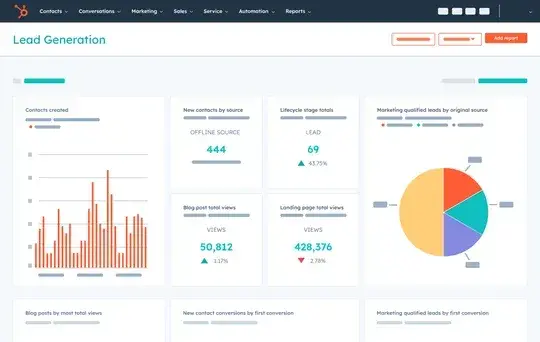In this post, I’ll explain the different UX metrics, dive into which you should choose, and then review how to use them to improve your site.
Table of Contents
- How to Choose, Track, and Measure the Right UX Metrics
- What are UX metrics?
- Why You Need to Measure More Than One UX Metric
- UX Metrics You Should Measure
- Best Practices for Measuring UX
- Getting Started With UX Metrics
What are UX metrics?
User experience (UX) is the discipline focused on the study and improvement of how people interact with websites and applications. UX metrics are the data points collected to assess and understand how well your user experience is performing.
UX metrics reflect the attitudes and behaviors of real people, which can be somewhat difficult to quantify but can be measured by things like:
- How often a user clicks a particular link.
- Page loading speeds.
- Task completion time.
In other words, to understand your users' experience on your website, sometimes you need to look past the marketing data and consider how humans behave and interact with your product or service. Your marketing initiatives no longer matter if a user’s experience is subpar.
A good look at UX metrics will give you a general sense of the user’s overall experience with your product.
UX metrics help align customer satisfaction with your company’s business goals. Ultimately, they should be used as an indicator for updates and improvements to your product or service to increase customer satisfaction.
How to Choose, Track, and Measure the Right UX Metrics
- Define the goals of your website or application.
- Talk to your stakeholders about their needs.
- Define the categories of user experience you want to assess.
- Pick a range of metrics supporting your chosen categories.
- Begin measuring your UX metrics.
- Assess, improve, and refine.
- Keep measuring and improving.
I know firsthand that measuring performance on the web, and discerning the right metrics to look at, can be difficult. So, I like to use one question to guide which UX metrics I track and prioritize. I ask myself: What am I really trying to measure?
To answer this question, let’s walk through the process I use when I’m trying to set up a strategy for measuring user experience.
1. Define the goals of your website or application.
You won’t be able to measure how well your website or application is serving your users without first understanding what you’re trying to enable them to do. Are you selling something? Sharing information? Encouraging users to sign up for a service?
It might sound like a simple first step, but you’ll want to have a clear and consistent understanding of what you want to enable your users to do before selecting your UX metrics.
2. Talk to your stakeholders about their needs.
Unless you’re working on a solo project, your UX metrics will inform the work and choices of other people on your team or in your wider organization. I recommend you talk to them early to learn which UX metrics could support their work.
3. Define the categories of user experience you want to assess.
UX metrics can help you assess how usable your website is, how satisfied customers are using it, the engagement around your website or application, and how users impact your business goals.
I recommend using the goals you defined in step one and the feedback from your stakeholders in step 2 to decide which UX categories to focus on. They are generally organized into these three categories:
- Descriptive. These UX metrics reflect how a user behaves when using your product.
- Behavioral. While similar to descriptive metrics, take a closer look at how customers interact and engage with your service. (Think, page clicks or downloads.)
- Attitudinal. Describes a user’s overall perception or attitude when engaging with your product or service.
Pro tip: Most projects will need to measure multiple categories to support their goals and stakeholder needs.
4. Pick a range of metrics supporting your chosen categories.
Once you’ve decided what categories of user experience to measure, it’s time to select the individual UX metrics that will help you assess how your project is performing in your chosen categories.
5. Begin measuring your UX metrics.
Once you’ve chosen your individual UX metrics to assess performance for your selected categories, it’s time to start collecting data. Many marketers will present their data in a spreadsheet or shared folder, but using a reporting dashboard can streamline how you collect and understand your data.
Shameless plug: HubSpot’s Dashboard & Reporting Software makes it easy to maintain a single source of truth for all your metrics.

6. Assess, improve, and refine.
Just collecting UX metrics won’t improve your project.
You’ll want to use the data you collect to improve your website or app. You’ll also want to critically examine the UX metrics you’re using as you learn and refine your approach. For instance, you may want to change or replace individual UX metrics or focus on other UX categories to better guide your project.
7. Keep measuring and improving.
Improving your user experience is an ongoing process. Keep measuring your chosen UX metrics and then using the data to improve your website for your users. Continuously refine your UX research approach.
Why You Need to Measure More Than One UX Metric
Many marketers will recommend selecting a single metric to focus on, often described as a “one metric that matters.”
However, I don’t recommend this practice for measuring UX performance.
Here’s why:
- Understanding how your website can be improved for your users is more complex than a single metric can support.
- A single metric can create a pass/fail mindset where you’re overly focused on a one indicator of performance.
Instead:
- Think about the metrics that support your projects as a series of complementary points of assessment from the categories that matter most for your users.
Next, let’s explore the different categories of UX performance to measure and the individual UX metrics that can tell you how you perform in each category.
UX Metrics You Should Measure
There are four primary UX metrics you should measure to get an overall sense of how well your website or application is serving your users.

1. Usability Metrics
The usability UX category looks at the ease of use of your product or service. While ease of use sounds subjective, there are a range of ways to collect data that support understanding usability.
UX metrics for usability are often measured through observed user research. For example, you might have a select group of users complete a task within your product with an observer watching, recording, and comparing the behavior of the users completing the task.
Here are three usability metrics that would be gathered in this way:
- Task Completion Rate
- This UX metric is useful in understanding how product changes impact usability.
- How to measure: Gather a group of test users together to measure this metric. Ask them to complete a task while you observe. Then, calculate the task completion rate by averaging the time it takes test users to complete a task and dividing that average by the total number of participants.
- You may want to compare the task completion rate times of experienced users to those of new users. Use the experienced user data points as the baseline data.
- Success Score
- This metric reflects the question, “Were users able to complete a set task?”
- How to measure: Calculate the success score by dividing the number of completed tasks by the total number of attempts. The higher the number, the higher the success rate of the users testing your product.
- These UX metrics can also be measured for your competitors by asking your test users to complete similar tasks using their website or app.
- Error Rate
- This UX metric measures the total number of mistakes or individual error occurrences observed in test users accomplishing a set task.
- How to measure: Divide the total number of observed errors by the number of times the test users attempted the task.
- Decreasing the error rate can dramatically improve your project’s efficiency.
2. Customer Satisfaction Metrics
Customer satisfaction is an essential tool for assessing your product’s user experience. Metrics measuring customer satisfaction can be qualitative (open-ended feedback from your users) and quantitative (fixed numerical outputs).
- Customer Satisfaction Score (CSS)
- Surveys are a common tool for collecting quantitative data to understand how happy (or unhappy!) your users are with different aspects of your product. It’s vital to design customer surveys to be easy to understand and quick for customers to complete.
- How to measure: Your customer satisfaction score can be calculated as a percentage of surveyed customers replying positively to individual questions or can be averaged to get the percentage of positive responses to all survey questions.
- Any time you survey your customers, you also have the opportunity to collect qualitative data about their satisfaction. Consider offering them space for open-ended feedback in your surveys.
- Single Ease Question (SEQ)
- This one-question survey usually asks customers, “Overall, how difficult was this task?” Asking just one question means that the survey for your SEQ metric is easier to design and faster for your customers to complete.
- How to measure: The survey question is often designed to ask customers to rate the ease of task completion from 1 (very hard, an undesirable ranking for customer satisfaction) to 10 (very easy, the best score for customer satisfaction).
- Changes in the average score for this metric should be carefully monitored, especially when your project is making changes or updates. Note that the SEQ is often used to supplement the task completion rate metric.
- Net Promoter Score (NPS)
- This metric is gathered through another single-question survey, this time asking your customers how likely they would be to recommend you to people they know.
- A higher average NPS for your surveyed customers reflects better performance in customer satisfaction.
- Customer Churn Rate (CCR)
- Determining the churn rate is one good indicator of how well your customers receive your product. The churn rate reflects the number of customers that stop doing business with you in a given timeframe.
- How to measure: To calculate this rate, first you’ll need to define a timeframe. For example, you may want to look at just a six-month window. Then, subtract the number of customers from the end of the period from the number at the beginning. Next, divide that number by the number of customers at the beginning of the timeframe. This number is your churn rate.
3. Engagement Metrics
The engagement category looks at how often and how positively customers interact with your website or application. Large positive changes in engagement metrics can be a great early sign that you’re making improvements that are likely to contribute to your project’s goals. But a large drop in engagement could be an important early signal that something has gone wrong.
Here are some metrics that reflect engagement and can be impacted by UX improvements.
- Page Views
- The number of page views your website receives in a designated time frame is a simple-to-capture metric to determine engagement.
- How to measure: Start tracking this metric for several months. The first month’s data will be the baseline data point. Ideally, you will want to see an upward trend in page views. If page views flatline or begin to decline, that is a sign your customers are no longer engaging with your content.
- Session Duration
- Session duration measures the time customers spend on your website or page. An engaged customer will spend more than a few seconds interacting with your content. If many or most of your users leave your website or app too quickly to have met any of your business goals, there may be user experience or context improvements needed to keep them around longer.
- User Feedback
- This metric can be measured in a couple of ways. Take a look at the number of comments on your website. An active comment section means your customers are engaged with the content. Alternatively, send your customers an open-ended survey.
- The volume of user feedback being generated can also act as a valuable metric reflecting engagement. A low quantity of user feedback reflects a smaller user base, less willing to give feedback. A high quantity of user feedback could be a good sign, but it needs to be contextualized. If you’re getting a lot of feedback and it’s broadly positive, that’s great. If you’re getting lots of negative feedback, you may have challenges ahead.
4. Business Impact Metrics
While UX often has a less directly observable impact on sales and business goals than marketing, it is important to monitor for changes in business impact tied to UX changes.
Being able to connect positive business impact to your UX improvements can help you make the business case for future investment in improvements. Likewise, being able to catch and correct negative business impacts tied to UX changes can help minimize damage from mistakes and missteps.
Your sales and marketing teams are likely already measuring some of these common business impact metrics, which can help inform your approach to improving user experience.
- Conversion Rates
- Conversion rates are a good indicator of the business impact of your user experience. If you offer a product or service with an additional upgrade, you can measure how many users upgrade to the paid product — or don’t. Depending on the result, you can determine if changes need to be made to improve UX.
- Customer Lifetime Value (CLV)
- Customer lifetime value measures how valuable a customer is to your company by looking at how much they spend over the total time they do business with you. In general, retaining existing customers is less expensive than gaining new ones, so understanding which customers are the most valuable can help you optimize to support them better.
- Return on Investment (ROI)
- To determine how ROI is affected by user experience, compare the total amount of time, effort, and funds spent on UX with the overall business. This will give you a good idea of the UX's impact on your ROI.
Measuring UX metrics and keeping up with the data can feel overwhelming. However, there are tools, like HubSpot’s Customer Journey Analytics tool, to help you keep track of and compare UX metric data.
Best Practices for Measuring UX
Measuring UX metrics should be an essential part of your business strategy, but not every metric will provide valuable insight to your company. Below are some of my best practices and tips to gain the most value from UX metrics.
Side quest: If you’re ready to learn more about user experience, check out this post on How to Create Seamless & Intuitive Experiences.

1. Define measurable goals.
Before measuring any part of the user experience, you should define clear, measurable goals. Your goals will ultimately help you pick the best metric to measure. For example, if you wanted to increase user speed through a contact form, you might determine the task completion rate first.
Using this information, you can select a reasonable goal and the means to measure it.
Pro tip: Writing your goals with our SMART goals template will help you ensure your goals are specific, measurable, attainable, relevant, and time-bound.
2. Obtain baseline data.
The point of UX metrics is to determine which part of the user experience is lacking — that way, you can work to improve the overall experience. But before you make improvements, you should first collect baseline data.
Baseline data will be your reference point to understand changes to user experience based on the changes you make to your product or service.
Pro tip: Make sure you set a specific length of time for each metric you wish to measure. After you establish the timeframe, keep it the same throughout your tests. This will give you an accurate data set.
3. Measure multiple UX metrics.
Focusing on just one metric or category won’t give you a holistic view of user experience. By looking at a range of user experience categories, you’ll be able to better understand how you can make improvements that build towards your goals. Collecting data from multiple metrics for these categories reduces the risk of over-focusing on a single datapoint.
Pro tip: Choose various UX metrics to give your company a clear understanding of the user experience.
4. Measure for qualitative and quantitative metrics.
Qualitative metrics, like customer feedback surveys and single ease questions (SEQ), can sometimes tell you more than a single number. Qualitative metrics allow for open-ended discussion between you and your customers. For example, a survey lets you learn about customer pain points and potential solutions.
Quantitative data, on the other hand, is also essential. This kind of data will provide you with a solid understanding of performance concerning business goals. You need both of these kinds of metrics when researching user experience.
Pro tip: Choose both quantitative and qualitative UX metrics. This will provide a solid understanding of your customer’s experience with your product.
Getting Started With UX Metrics
User experience can determine the success of your product or service. Fortunately, UX metrics allow you to determine the overall user experience. Use these metrics to help guide and implement changes to your product or service — but be sure only to implement changes that will improve your customers’ experience.
Editor's note: This post was originally published in August 2023 and has been updated for comprehensiveness.
User Experience
.png?width=112&height=112&name=Image%20Hackathon%20%E2%80%93%20Square%20(10).png)

.png)

![How to become a UX designer, a step-by-step guide [expert tips]](https://53.fs1.hubspotusercontent-na1.net/hubfs/53/become-a-ux-designer-1-20240731-321437.webp)

![How to Add a Parallax Scrolling Effect to Your Website [Examples]](https://53.fs1.hubspotusercontent-na1.net/hubfs/53/scroll-Aug-11-2023-05-24-08-8793-PM.png)

![20 UX Design Examples Hand-Picked by Experts [With Analysis]](https://53.fs1.hubspotusercontent-na1.net/hubfs/53/ux-design-examples-1-20250404-8425368.webp)

